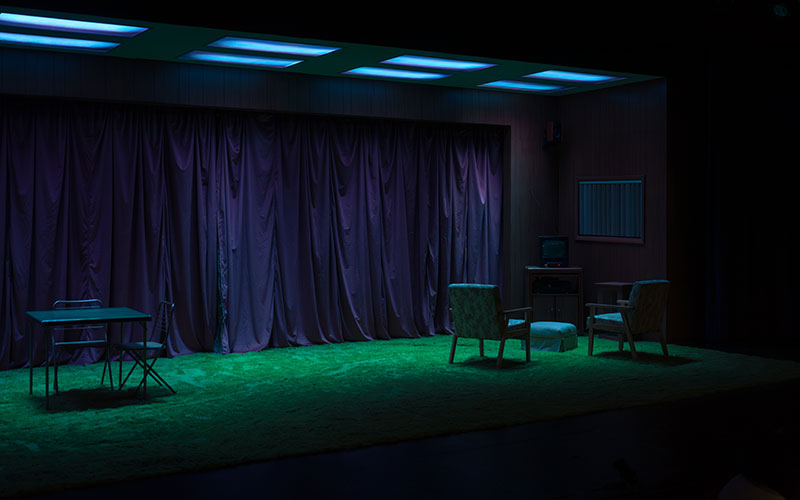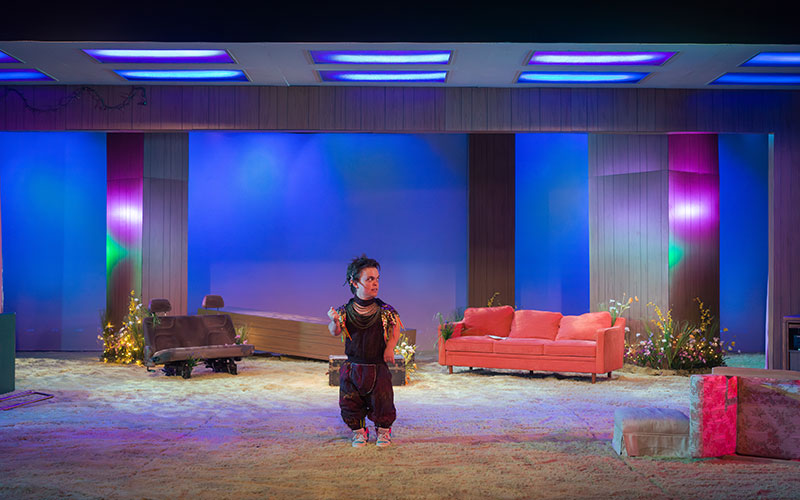Photos by Cason Doyle. Videos by Franco Giacomarra and Kelly Prinz
Exactly how much work goes into a theater production? To find out, we went behind the scenes with the cast and crew of Fordham Theatre’s A Midsummer Night’s Dream, last fall’s mainstage show, just before opening night.
138 Hours of Rehearsal
After auditions were held and parts cast, Fordham student actors began conducting research and learning lines before starting a month of rehearsals. Working alongside acclaimed director Ryan Quinn and a team of student stage managers, the 13 actors spent about 5 hours a night for 5 nights a week crafting the show. Then they moved on to 28 hours of technical rehearsals and 10 hours of dress rehearsals before the show opened.

“Our director Ryan Quinn was really amazing and receptive to ideas. … Not everything made it! But we all had a chance to contribute something,” said Tyler Bey, a senior at Fordham College at Lincoln Center, who played Bottom in the production. “Just that opportunity for possibility, where the director and the actors come from a place of willingness and openness to just play, is really freeing and makes the whole thing much more fun.”
11 Days to Build
All technical elements—lights, sound, video, scenery, and costumes—were carefully designed and built as efficiently as possible during this short but crucial window of time. Students worked under the mentorship of faculty and industry professionals, such as Brittany Vasta, the show’s set designer, to create high-quality designs.
“Working with Brittany was a huge leap in what I have done in the past,” said Sam Deetjen, a junior at Fordham College at Lincoln Center and the show’s assistant set designer. “I haven’t really worked with any professionals in the set design world.”
190 Lighting Units and 11 Loudspeakers
These critical technical elements work in tandem to help create the audiovisual world of the production and support the scenery, costumes, and performers. Each of these units is individually hung, focused, and circuited to create specific moments throughout the show—and they must be checked and adjusted accordingly for each performance.
16 Green Carpets
To create a seamless stage floor, these carpets were sourced, measured, and connected together manually by student workers. The design concept for the show—set in both a nursing home and a magical forest—utilized these green carpets to tie the two worlds together.
“That moment when the curtains open and you reveal the whole upper area of the set, there was a little bit of an ‘ooh’ from the audience,” said Tim Zay, Fordham Theatre technical director. “It was nice because it really did open up this big vast expanse. It’s always good to see the design work get appreciated.”


500 Fairy Lights
Student workers and designers embedded these tiny lights throughout the set and costumes to create the magic of the fairy characters and the world they inhabit.
The production featured 35 different costumes, powered by 7 personal battery packs.

249 Cues
Individual cues from departments including lights, sound, scenery, and costume are built and tested throughout technical rehearsals under the leadership of Production Stage Manager Skyler Purvis, a senior at Fordham College at Lincoln Center.
The production featured 80 sound cues, 34 video cues, and 135 lighting cues, each one triggered by a specific operator on Purvis’s “go.”
7 Performances
Fordham Mainstage productions run for 7 public performances over the course of 10 days, not including the several full show runs, dress rehearsals, and brush-ups throughout the week. This professional-level workload is a challenging but invaluable experience for student technicians and actors.
“I’ll have to see if the vocal training kicks in when we have the 2 p.m. and the 8 p.m. show,” said Bey with a laugh. “I’ve never really done that, but my friends and I said, ‘If we want to do this, we better be ready for eight shows a week.’”

